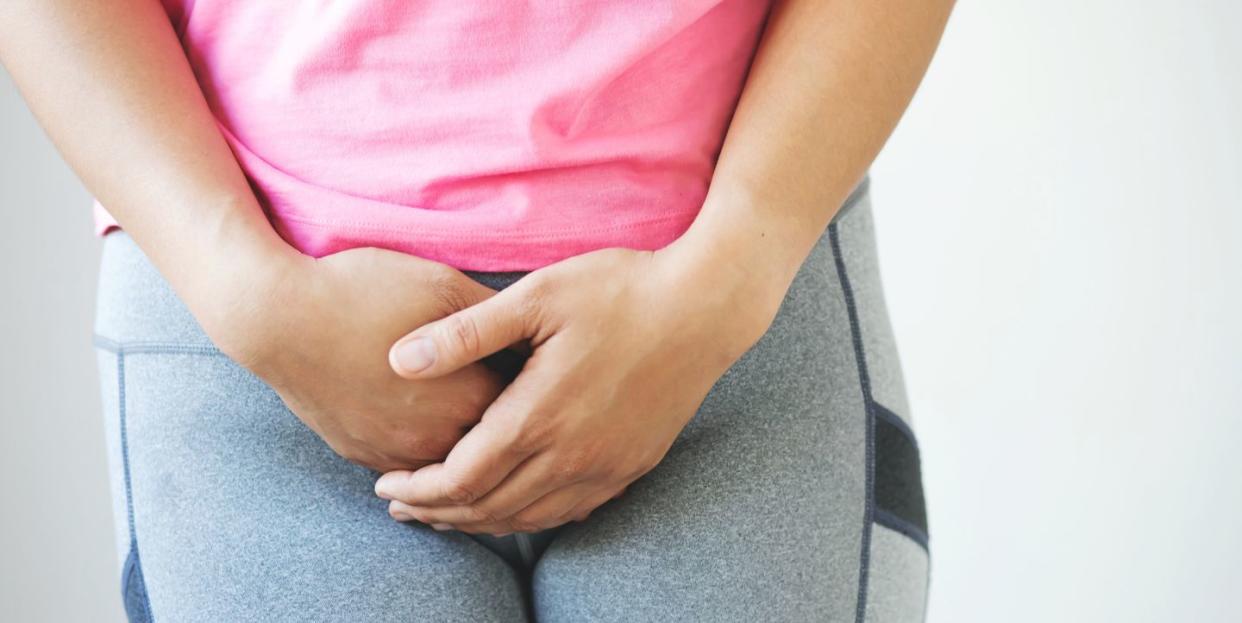You Might Need To Rethink Your Workout Underwear If You Get Itchy In The Vagina Area

At some point in your life, your vagina has been itchy—that’s just part of having a vagina. But how do you actually soothe an itchy vagina in a safe and healthy way, and figure out the cause to nix it for good? Asked and answered for ya, here.
“Vaginal itchiness is extremely common, but there’s a big difference between having a little itch and being up all night thinking you can’t stand this,” says Lauren Streicher, MD, an associate professor of clinical obstetrics and gynecology at Northwestern University Feinberg School of Medicine.
To be clear, if you have ongoing vaginal itchiness, you should go to the doctor to get it checked out. If you spot blisters or a rash down there, it could be a sign of an STI, Dr. Streicher says. Pubic lice can also cause really intense itching that needs to be treated with prescription drugs, notes Jonathan Schaffir, MD, an ob-gyn at The Ohio State University Wexner Medical Center.
“In addition to infections (yeast or bacterial) or STIS, an allergy or skin condition might be to blame, and the vagina (the inside canal) and/or the vulva (everything on the outside) might be involved,” adds Alyssa Dweck, MD, an ob-gyn based in Westchester County, New York.
But if you've already visited your health care provider and are just dealing with occasional irritation down there, there*are* a ton of home remedies to soothe vaginal itchiness that can help, ahead.
1. Check your soap.
Your vulva is a sensitive area and some soaps, especially ones that contain delicious-smelling fragrances, can make you itchy down there, Dr. Schaffir says. Try switching to a hypoallergenic soap like Cetaphil and see where that gets you. “Sometimes just eliminating a particular product will make all the difference,” Dr. Streicher adds.
2. Rethink using pads.
Some women experience allergic reactions to their menstrual pads that can trigger a serious case of the itches. That's because some menstrual pads contain perfumes that can be irritating, says Dr. Schaffir. If you notice you get especially itchy around your period, stop using your go-to pads and opt for an unscented variety, or even organic versions of pads and tampons.
3. Use an over-the-counter cream, like Vagisil.
Vagisil cream is designed to help fight vaginal itch and can soothe things down there, Dr. Schaffir says. It works by forming a protective barrier over your skin to make it feel better and save you from developing more irritation. Use this for any itchiness you suspect may be caused by antibiotics or discharge.
4. Apply Vaseline.
If you’ve been itchy, it may also burn when you pee, so add a little Aquafor to the area, clean with water after you go, and be gentle with the wiping, Dr. Streicher says. While petroleum jelly can make a yeast infection worse (if you have one), Aquafor is more breathable for the skin while still creating a barrier down there, she says. Plus, it can be soothing.
5. Use yeast infection cream.
A lot of women assume they have a yeast infection whenever they get a vaginal itch, but it’s not always the case, Dr. Streicher says. Still, if you’ve had a yeast infection before and you know that’s what you’re dealing with, an OTC yeast infection medication should help. Keep in mind that you can also get a yeast infection in your vulva—and there are creams for that, too.
Definitely see your doc if you're unsure whether the symptoms you're experiencing may be related to a yeast infection.
6. Take a sitz bath with lukewarm water.
A hot bath can provide more than a little relaxation when you’re dealing with itchiness down there. Feel free to add plain Epsom salt or oatmeal bath such as Aveeno Soothing Bath Treatment, Dr. Dweck says. Afterward, you can dry the vagina area with a hair dryer on a cool low setting.
7. Try an over-the-counter hydrocortisone cream.
Hydrocortisone creams are often used for minor skin irritations, so they can be helpful for external vaginal itching as well. Just don’t insert these creams inside the vagina, as it can worsen inflammation.
8. Apply an ice pack or other cooling therapy.
Applying a cold treatment like an ice pack or over-the-counter cooling pad can provide relief down there, says Dr. Dweck. Just be sure to use them with a cloth barrier such as your underwear or a towel rather than applying directly to the skin, as you could further irritate it.
9. Opt for cotton underwear.
Certain fabrics can lead to extra irritation and itching, so sticking with cotton panties may be your best bet, says Dr. Dweck. Better yet, opt for organic, she adds.
10. Try an alternative hair-removal method.
If you shave your bikini area and notice that it’s always followed by itchiness, Dr. Dweck recommends considering other methods, such as laser hair removal, electrolysis, or waxing.
11. Try a non-drowsy OTC antihistamine.
Medications like Benadryl are known to help relieve allergic reactions to the skin, so trying them for itch issues may prove to be helpful as well, says Dr. Dweck.
12. Moisturize the external area.
“From time to time, vaginal itching may be due to dry skin, so consider a hypoallergenic moisturizer without petrolatum which may worsen the issue,” says Dr. Dweck.
13. Consider hormone therapy.
If all else fails, vaginal estrogen might do the trick if low estrogen is the issue, which can be the result of experiencing menopause, taking hormonal birth control, breastfeeding, or taking certain medications, explains Dr. Dweck. “You’ll need a prescription, so talk to your gyno if you want to consider this option.”
The bottom line: While these home remedies for vaginal itch can be a temporary solution, if you’re struggling with an itch that won’t quit, it’s time to see your doctor to get it checked out.
You Might Also Like

